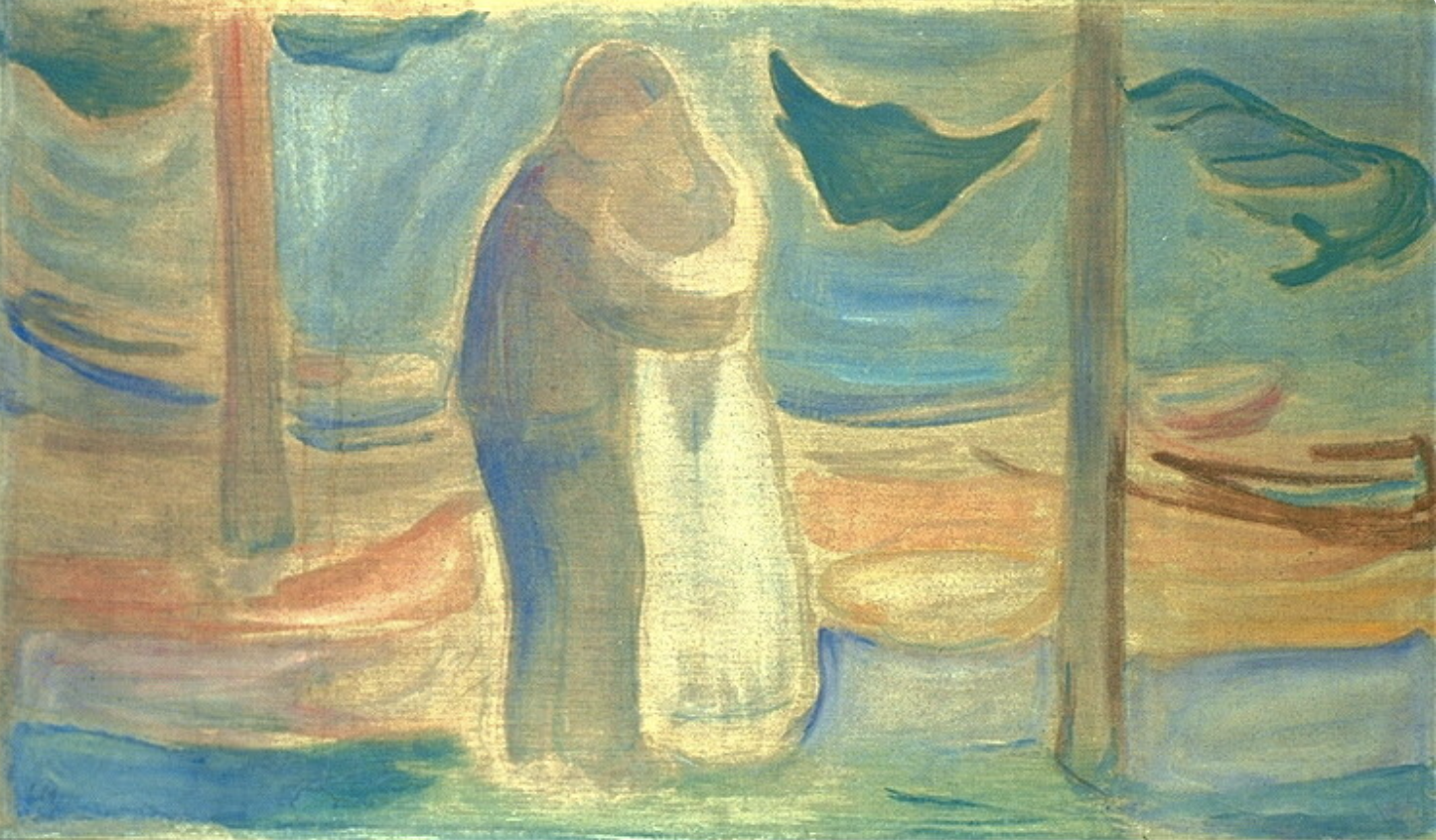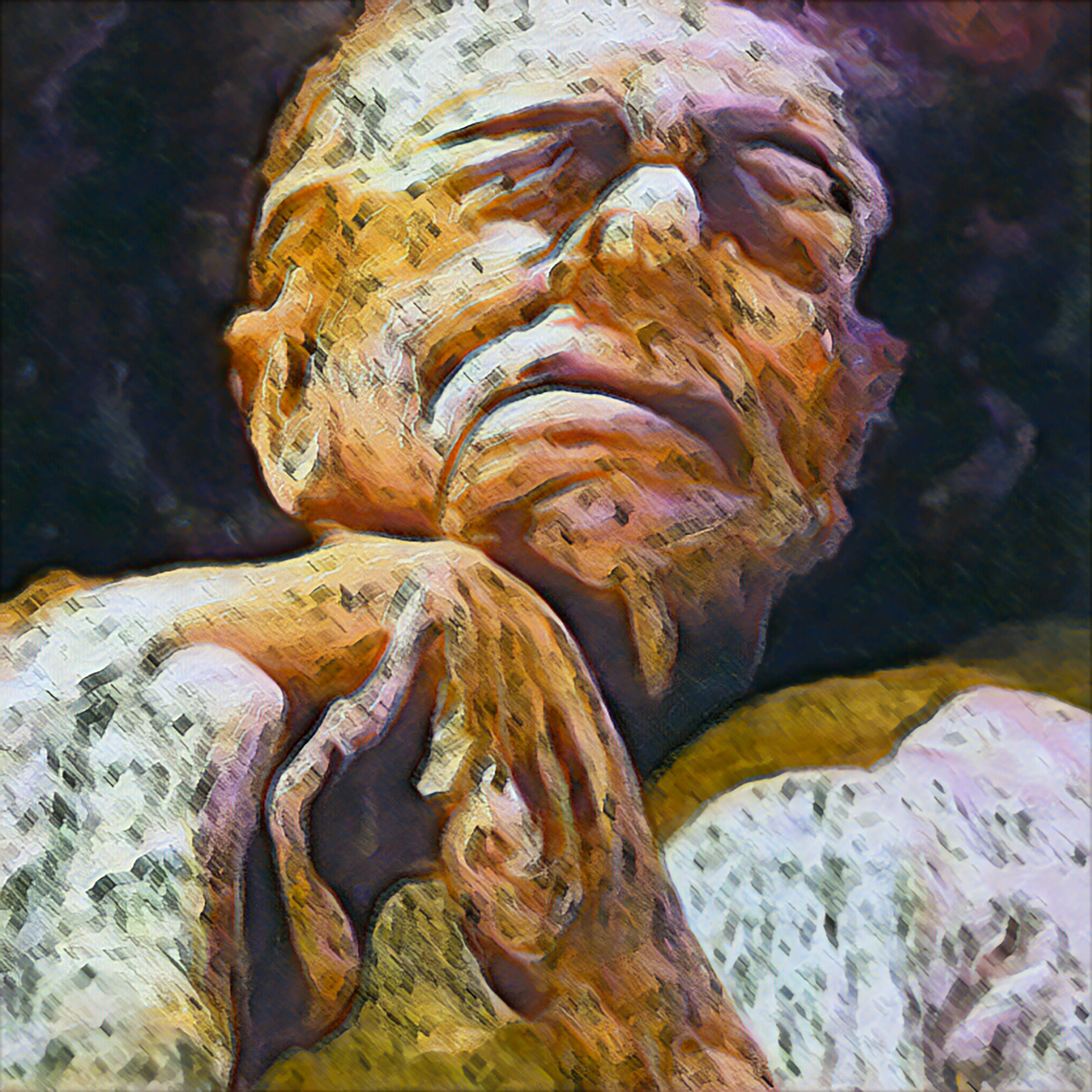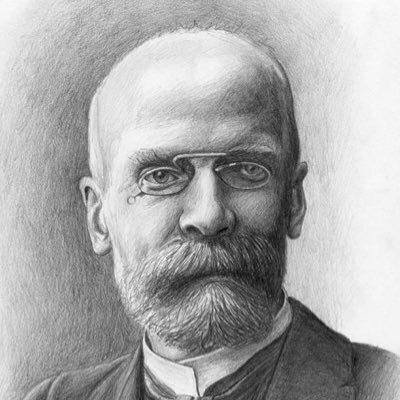
Kiss on the Beach, Edvard Munch, ca. 1906–07
In “Jumpers,” a sobering 2003 article for the New Yorker, journalist Tad Friend collects a tragically large array of stories of suicide at the Golden Gate Bridge in San Francisco. Since its construction in the 1930s, there have been more than one 1,800 such jumpers, though perhaps none as striking as one patient of Dr. Jerome Motto, a California psychiatrist and leading suicide prevention activist in the 1970s. According to Dr. Motto, “The guy was in his thirties, lived alone, pretty bare apartment. He’d written a note and left it on his bureau. It said, ‘I’m going to walk to the bridge. If one person smiles at me on the way, I will not jump.’”1 Apparently no one did.
The histories of suicide and dignity are deeply intertwined in Western culture. Pioneering authors of the very notion of dignitas in ancient Roman Stoicism considered death on one’s own terms to be dignified indeed when certain circumstances are met,2 and today medically assisted dying advocacy groups argue similarly on liberal grounds.3 But dignity has also served as a lynchpin of moral condemnations of suicide and euthanasia—historically by medieval Christian authors, and still today in the Catechism of the Catholic Church, among other moral authorities.4
No wonder then that dignity has its detractors when it comes to matters of life and death. In a widely cited article, Ruth Macklin declares that dignity is a “useless concept” for medical ethics—a secularized leftover from “religious sources” (not intended as a compliment).5 Popular secular writer Steven Pinker deems dignity a “squishy, subjective notion, hardly up to the heavyweight moral demands assigned to it.”6 Even Catholic philosopher Alasdair MacIntyre has recently voiced similarly uncompromising criticisms of the notion.7
Ongoing euthanasia experiments in countries such as Canada and the Netherlands make for a particularly palpable symptom of this dignity dilemma. Canada, for example, is poised to expand its eligibility for medical assistance in dying to patients who establish “irremediable” mental illness as their primary or sole justification.8 The prospect has already occasioned a flurry of criticism from researchers, journalists, and practitioners who have noted (among other things) credible reports of patients seeking such assistance on account of social distresses such as poverty and loneliness.9 There are even patient reports of (indirect) external “pressuring” to seek medical assistance in dying.10 Alexander Raikin summarized the grim situation rather powerfully when he noted recently that in Canada, “there is a national suicide prevention hotline you can call 24/7, where sympathetic operators will try to talk you out of killing yourself. But today there are also euthanasia hotlines, where operators will give you the resources you need to carry out your wish.”11
There are no doubt important differences between impulsive suicidal behavior and a more “formal” process of seeking death on one’s own terms in concert with medical professionals.12 Nevertheless, even those most sympathetic to such programs must recognize the threat of moral incoherence here. If we ask much of dignity, it’s not always clear what it asks of us.
It seems appropriate to ask how a culture could reach a point at which concurrent suicide prevention and euthanasia hotlines could be thinkable, much less enacted. When it comes to the intellectual history of suicide in the West, the story usually proceeds in three acts.
The first act is often rendered as “ancient” or “classical,” with special attention paid to influential authors of Greek and Roman antiquity. Some of these authors display a certain level of ambivalence when it comes to the morality of suicide.13 Nevertheless, as Andrei Zavaliy observes, “barring a few exceptions, the ancients distinguished certain cases of the taking of one’s own life as either honorable or at least justifiable.”14 Cicero and Seneca are paradigmatic representatives of this consensus about the moral justifiability of suicide in the ancient world, appealing to the importance and legitimacy of weighing the “quality” of one’s life with respect to conditions of human dignity. As Cicero puts it, for example, “When a man’s circumstances contain a preponderance of things in accordance with nature, it is appropriate for him to remain alive; when he possesses or sees in prospect a majority of the contrary things, it is appropriate for him to depart from life.”15 In the intellectual worlds of Greek and Roman antiquity, suicide was best understood as an individual act that can be morally justified—or even called for—when certain unavoidable circumstances cannot meet the conditions befitting human dignity.
This changed with the rise of Christianity, which marks the second act of this common story. In fact, according to philosopher Michael Cholbi, “The advent of institutional Christianity was perhaps the most important event in the [Western] philosophical history of suicide,” since among other things it gave unified intellectual and sociocultural voice to the position that suicide is a morally condemnable act.16 Although there is not much on the subject in what would eventually become canonical Christian Scriptures, as early as the second and third centuries we find explicit condemnations of suicide from early Church fathers such as Justin Martyr and Clement of Alexandria. Often these condemnations come as corrections of real or perceived conflations of suicide and martyrdom in Christian teaching. “Lest any one should say to us, ‘All of you, go, kill yourselves and thus go immediately to God,’” writes Justin in his Second Apology, “if we do act thus, we ourselves will be opposing the will of God.” Clement makes a similar point: “Those who have rushed on death banish themselves without being martyrs inasmuch as they have not known the only true God, but give themselves up to a vain death.”17

Death with Dignity, David S. Soriano, 2022
But it is Augustine who offers the most detailed, influential arguments against the morality of suicide across several texts written at different points in his life—so much so that he is generally credited as the preeminent voice on the subject in Christian theological history. Many of his arguments characterize suicide as directly contravening the will of God for one’s life, including the one given in De civitate Dei I.20: “God’s command ‘Thou shalt not kill,’ is to be taken as forbidding self-destruction, especially as it does not add ‘thy neighbor.’”18 Augustine’s rejection of the suicides of Roman exemplars Lucretia and Cato reflects his commitment to human life as owed ultimately to “a divine grace, above all earthly dignities that totter on this shifting scene” (preface), and therefore also the abovementioned Stoic rationale for circumstantial suicide. Christians should not “obviate sin by sin” (I.25) in rejecting the gift that is their own life.
But even if he does advocate a posture of understanding and forgiveness toward some victims of suicide (I.17), there is no question that Augustine considered it a “detestable and damnable wickedness” in other cases (I.25)—a position that would influence later teachings that most of us today would find ruthless regarding the eternal destiny of sufferers. The legacy of this severe and arguably pathologizing approach to suicide as an abominable, punishable affront to the will of God plays an important role in this story—not only on account of its own distinctives, but also due to its position with respect to the third and final act of our story: namely, the demoralized, empirical approach of the Enlightenment.
Many point to John Donne’s Biathanatos (1607) as the first “modern” defense of the morality of suicide, the full title of which includes the claim that it is “not so naturally sin, that it may never be otherwise.” David Hume’s influential essay “On Suicide” refers to Biathanatos, and marks perhaps the most influential defense. Hume adopts a skeptical approach to moral condemnations of suicide based upon notions of God’s providential will for one’s own life: “Providence guided all these causes, and nothing happens in the universe without its consent and co-operation. If so, then neither does my death, however voluntary, happen without its consent.”19
More important than his objections to religious condemnations of suicide, however, is Hume’s contention that suicide “may be free from every imputation of guilt or blame.” This is important because it represents a guiding principle for what would eventually become a reconceptualizing of suicide altogether as a non-moral matter. One way to avoid pathologizing victims is to completely demoralize the matter altogether.
Something like this basic Humean contention shaped theoretical approaches to suicide adopted in the early stages of psychiatry and sociology in the nineteenth and twentieth centuries. So-called moral statisticians such as Adolphe Quetelet developed methods invoking principles already prevalent in the natural sciences to understand suicide as an empirical phenomenon first and foremost—that is, something to be explained by reference to social causes and perhaps even laws governing human societies generally.20 Indeed, Émile Durkheim’s classic work, Suicide (1897), approaches suicide as an effect of the level of “integration” characterizing the varied relationships in a given social group.21 Durkheim’s integration thesis is still highly regarded among social scientists today, but again for our purposes what is most interesting is the reconceptualization of suicide as a fundamentally nonmoral matter. Margaret Pabst Battin summarizes the point in her magisterial 2015 volume, The Ethics of Suicide:
These thinkers in effect silenced the ethical debate, since they saw suicide as socially or psychiatrically caused rather than chosen. This laid the foundation for the view that, if suicide is not voluntarily chosen in any robust sense, it cannot be said to be culpable—not morally wrong, not sinful, and not criminal. Although debate over individual responsibility for suicide still continues, it has until recently been largely obscured by the dominant professional view that suicide is a product of mental illness, committed by people in the grip of depression or other psychopathology, hence incapable of reasoning clearly, and that, therefore, there really is no ethical issue here.22
These three stages mark important turning points in the conceptualizations of suicide in Western intellectual history: (1) the near consensus of the ancient world that at least certain forms of suicidal behavior are morally justified; (2) the Christian blanket prohibition of suicide, with special reference to the will of God with respect to one’s life; and finally (3) the European Enlightenment’s “empirical” (sociological, psychiatric, etc.) approach to suicide as a fundamentally nonmoral matter.
But if it is Durkheim who is preeminent among such moral statisticians, a qualification is in order. The core thesis of Suicide is that “the social suicide-rate can be explained only sociologically. At any given moment the moral constitution of society establishes the contingent of voluntary deaths.”23 Now of course in one sense this theoretical contention is merely an explanation of the covariance of suicide rates and the level of social integration in particular societies. His data betrays distinctive social patterns with respect to marital, occupational, and religious affiliation, and thus similarly distinctive suicidality.

Émile Durkheim
But more interesting for our purposes is another reconfiguration—that is, Durkheim’s peculiar sense of what counts as moral. What morality is not are “lofty, clearly imperative precepts… deriving their total reality from God.” For Durkheim, if our “moral dispositions” seem supernatural, this is not because they are manifestations of the transcendent; rather, it’s because the integrality of human societies extends beyond the psychology of individuals considered in themselves. When it comes to the true origin of morality, there are two options: “Morality either springs from nothing given in the world of experience, or it springs from society.”24 Of course, Durkheim does not think it sprang from nothing.
So Durkheim brings morality from a heavenly to an earthly city. Yet it is not because he wants to “destigmatize” suicide altogether. While critical of the “formal and severe” condemnation of suicide in Christian Europe in the late nineteenth century, Durkheim applauds his own culture’s moral achievement of recognizing “a kind of dignity which places [the human individual] above himself as well as above society.”25 Even if respectable scientists cannot countenance explicitly religious notions like a “spark of divinity” that is each individual soul, for Durkheim we can nevertheless maintain the kernel of meaning in the religious symbol: “the respect inspired in us by human personality” that implies an inviolable dignity that even the most noble has no right to transgress. In this remarkable passage, he outlines something like his moral vision for Western culture:
Our dignity as moral beings is therefore no longer the property of the city-state; but it has not for that reason become our property, and we have not acquired the right to do what we wish with it.… Suicide must be classed among immoral acts; for in its main principle it denies this religion of humanity.26
For Durkheim, even if such moral precepts are in themselves nothing more than reflections of a particular social organization at a certain stage of development, the dignity of human personality that is their content must be absolute and inviolable. This is why any social attitude toward suicide must proceed from the sacredness of each individual life, even, and perhaps especially, for this proudly secular “moral statistician.” If there is no social principle more central to the self-understanding of the West than the inviolable dignity of the individual soul, so the argument goes, then we as members of such a society have an obligation to “moralize” suicide at least to this extent: namely, the extent to which we recognize that something sacred has been lost when such acts are carried out. This is Durkheim’s “religion of humanity.”
Twentieth-century philosopher Ludwig Wittgenstein channeled a profound insight of the Abrahamic monotheisms when he noted in his “Lecture on Ethics” that even the totality of facts constituting our finite world could never offer more to us than relative value. That is, every apparently “value-laden” fact in this world would make sense only by reference to some other naturalistic fact. The “best” road to Granchester, as he famously put it, is really just the way you have to go if you want to get to Granchester in the shortest amount of time.38 One fact is explicable in terms of another.
Yet, as Wittgenstein recognizes, we seek more than relative value; we seek absolute value. I don’t just seek the best road to Granchester; I seek the best road for my life, absolutely. I don’t just seek safety from one physical illness or another; I seek absolute safety, whatever else might happen to me. What Wittgenstein noticed is that there is no naturalistic fact—nothing in the “big book” containing the totality of facts in a finite world—that could explicate this desire for absolute value. This is why he says that “ethics, if it is anything, is supernatural.”39 There is no way to capture the meaning of absolute value by reference to some naturalistic fact to which it is relative.
The question of the morality of suicide is supernatural in precisely this sense. As Frankl saw, “saying Yes to life in spite of everything” is recognizing something absolute.40 This Yes cannot be explicated in terms of some naturalistic fact in our finite world, since it is this very world as it is present to us that we are affirming therein. The task of suicide prevention is itself supernatural just as much as it is social, indeed as empirical evidence may well suggest.41 And maybe this is what Durkheim—and, arguably, our mainstream psychiatric institutions in the West—could stand to learn in a fourth act. If it is the dignity of human personality that is sought, then it must be sought supernaturally.
“If one person smiles to me on the way, I will not jump.” No doubt, each individual suicide retains some level of tragic mystery with causes beyond our comprehension. And yet, at least for those of us who understand ourselves as inheritors of the spiritual legacy of Abraham, dignity asks more of us.
For us, dignity asks for our unequivocal affirmation of our suffering neighbor’s life as a gift from the inexhaustible Life that is God himself. It asks for relationships, institutions and cultures that recognize our love for existence as the first perfection from which all others flow. It asks us to remind ourselves that scenes change, yes, but also that they do so ultimately by reference to the Life that is ever deeper and more original than death. It asks for clarity on such matters, to reject concurrent hotlines—whether they’re in institutions or in the soul—as they arise in our new world. Dignity asks us questions about life and death that go beyond the “empirical” machinations of stimulus and response, and to face up to the collective moral responsibilities that arise accordingly. It asks us too for widely available psychiatric care. It asks us that we smile at anonymous souls we pass on the Golden Gate Bridge.
We can recognize the greatnesses and infirmities in these eras of suicidology while also recognizing that we are called to something better. Cicero correctly saw our dignity as materially constituted in part. Augustine saw that life is a divine gift. Durkheim and Enlightenment authors saw that suicides involve victims as well as perpetrators. Maybe our task today is to re-moralize suicide—not by pathologizing sufferers, but by venerating their supernatural dignity.
Renovatio is free to read online, but you can support our work by buying the print edition or making a donation.
Browse and Buy